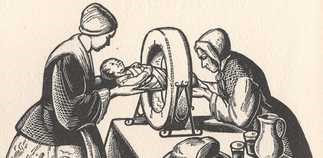|
I often get asked by parents if it is ok to move their baby into their own room before they are 6 months old because they are finding it difficult to sleep due to the snuffles, grunts and groans that their baby is making. I’m sure this is a question that resonates with all of us. Laying there in the night pondering what is causing your baby’s discomfort? And out of desperation spending and arm and leg on all the over the counter remedies – Colic Calm, Gripe Water, Infacol or taking the advice ‘just give him a teaspoon of water,’ and the self-doubt must be because I’m not burping him properly.
The truth of the matter is that your baby makes these noises 24/7 but at night it’s more obvious because it’s an environment that is dark and quiet when everyone is typically asleep! These noises are normal new-born noises. Babies have sensitive digestive systems and are nose breathers because they have large tongue that is needed for breastfeeding. Their nasal passages are narrow and even more surprisingly it is normal for new-born babies to aspirate small quantities occasionally without causing any harm (Nikki Mills ENT specialist – Symposium conference April 2018).  Pregnancy and birthing practices, politics and social norms have evolved as medical practitioners and mothers have become more experienced and knowledgeable with birthing methods. That being said, many societies’ rituals and customs have remained sacred throughout centuries. One such ritual that is gaining popularity is the “Lotus” birth. The placenta is the temporary organ that feeds the foetus inside the mother’s womb. In some cultures the expelled placenta holds a spiritual significance - some bury it, some eat it and some leave it attached until the umbilical cord dries up and it falls off on its own (up to 14 days) – this is a Lotus birth. This type of birthing practice had only been witnessed in chimpanzees until 1974 when Clair Lotus Day - pregnant and living in California - began to question the routine cutting of the umbilical cord. Her search led her to an obstetrician who was sympathetic to her wishes, and her son Trimurti was born in hospital and taken home with his cord uncut. More recently Jeannine Parvati Baker in the US and Shivam Rachana in Australia have both been strong advocates for this practice ever since. Dr. Sarah Buckley adopted this practice with her second child in 1993, when she placed the placenta in a hand sown red velvet bag and rubbed the placenta daily with salt and lavender until it fell off after six days. She described it as having a ‘slightly meaty smell’ and that it attracted the attention of her cat. A Lotus birth is an uncommon practice and therefore there are many unknowns but to date there is no research to support any benefits of this practice and there are warnings of associated risks such as bacterial infection. However, the spiritual meaning of it aligns with optimising mother baby synchrony after birth which is something we all aim to achieve regardless of our cultural practices. I am uncertain as then when it became common practice to cut the umbilical cord immediately after birth but it is now more commonly known that delayed cord clamping (30-60secs) or cord milking can increase iron storage of the infant, supporting healthy brain development. With this is mind, you can see how things can be done so differently but not necessarily wrong. Most of us try to keep ourselves informed as to what modern practices will optimise health and wellbeing of ourselves and our baby. I have been reflecting on all that we try and do to promote good health through preconception, pregnancy and birth, and most of it boils down to achieving and maintaining a state of calm. By remaining calm we can balance hormone production and this is at the heart of our bodily processes; from our menstrual cycles to our moods and energy levels. More specifically, keeping our fight or flight hormones (adrenaline and noradrenaline) at bay so that our more healthy and helpful hormones like endorphins, oxytocin, prolactin can be produced in higher quantities. We know that maternal stress during pregnancy does effect the developing foetus and can lead to adverse obstetric outcomes. Sadly, in the 21st century with dual working families, single parenthood, geographically dispersed families and friends, the energy demands of employment, home, parenting, family and friends it almost unavoidable. Therefore relaxation techniques during pregnancy such as massage therapy, hypnotic relaxation and breathing/tension release exercises are effective to keeping a state of calm and improving outcomes for mother and baby - demonstrating lower heart rates and blood pressure, and a lower incidence of gestational hypertension During birth, remaining calm becomes particularly important, not only to help with labour, but also to allow your body's helpful hormones - especially oxytocin and prolactin - to make bonding and attachment and initiating and maintaining breastfeeding as easy as possible. Keeping mother and baby in hormonal synchrony (as best you can) is vital for the healthy transition into motherhood. Becoming a mum is filled with both joy and pain - these emotions go hand and hand. The struggle with keeping that state of calm is now real. Postnatal stress and anxiety can impact on your life with your baby and effect your baby’s development negatively. So many of us today are goal focused and working towards the ideal. Getting caught up in self-blame thought processes. More often than not there is a silent competition at coffee group about whose baby is doing what first. Please do not rush your baby through developmental milestones such as self-settling, you are wasting your time and energy because they will do it when they are ready. Instead, focus your energy on keeping your state of calm and enjoying the journey. I like to compare sleep training to toilet training. You do not need to train your child to go to the toilet, just wait until they pull the nappy off themselves and refuse to wear one. Wouldn’t parenting be so much easier on our emotions if we simply just waited until they were ready! We would have a more respectful, healthier relationship with our offspring. As you can probably appreciate from the differing of birthing practices mentioned, some of them even rather unusual, infant care practices also differ. There is not right way and there is no ideal, there is however, more than one way to skin a cat. I must still have cats on my mind! References: http://www.pregnancy.com.au/resources/topics-of-interest/labour-and-birth/lotus-birth.shtml Nathan Wallis - The developing brain |
AuthorAmy and Elspeth CategoriesAll Bassinet Bottle Feeding Colic Cry It Out Discrimination Dr. Harvey Karp Fatherhood Goat Milk Infant Formula Mindfulness Pregnancy Routines Self Settle Sleep Regression Spacing Feeds Structure You Said Whaaaaat! Archives
July 2020
|
Proudly powered by Weebly
